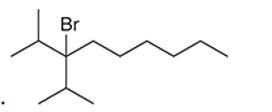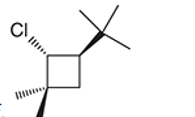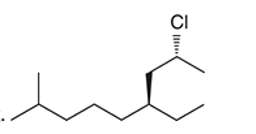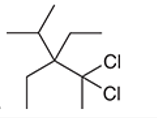
Concept explainers
(a)
Interpretation: The systematic name of the given organic compound is to be interpreted.

Concept Introduction: The IUPAC purposed the naming of organic and inorganic compounds. The name of the chemical compounds can be given with the help of certain rules. To name an organic compound, the longest carbon chain must be selected as the parent chain and the substituent must be marked as the prefix. The single, double, and triple bonds in a molecule are indicated by the primary suffix in the root word, but a
(b)
Interpretation: The systematic name of the given organic compound is to be interpreted.

Concept Introduction: The IUPAC purposed the naming of organic and inorganic compounds. The name of chemical compounds can be given with the help of certain rules. To name an organic compound, the longest carbon chain must be selected as the parent chain and the substituent must be marked as the prefix. The single, double, and triple bonds in a molecule are indicated by the primary suffix in the root word, but a functional group is indicated by the secondary suffix.
(c)
Interpretation: The systematic name of the given organic compound is to be interpreted.

Concept Introduction: The IUPAC purposed the naming of organic and inorganic compounds. The name of chemical compounds can be given with the help of certain rules. To name an organic compound, the longest carbon chain must be selected as the parent chain and the substituent must be marked as the prefix. The single, double, and triple bonds in a molecule are indicated by the primary suffix in the root word, but a functional group is indicated by the secondary suffix.
(d)
Interpretation: The systematic name of the given organic compound is to be interpreted.

Concept Introduction: The IUPAC purposed the naming of organic and inorganic compounds. The name of chemical compounds can be given with the help of certain rules. To name an organic compound, the longest carbon chain must be selected as the parent chain and the substituent must be marked as the prefix. The single, double, and triple bonds in a molecule are indicated by the primary suffix in the root word, but a functional group is indicated by the secondary suffix.
(e)
Interpretation: The systematic name of the given organic compound is to be interpreted.

Concept Introduction: The IUPAC purposed the naming of organic and inorganic compounds. The name of chemical compounds can be given with the help of certain rules. To name an organic compound, the longest carbon chain must be selected as the parent chain and the substituent must be marked as the prefix. The single, double, and triple bonds in a molecule are indicated by the primary suffix in the root word, but a functional group is indicated by the secondary suffix.
(f)
Interpretation: The systematic name of the given organic compound is to be interpreted.

Concept Introduction: The IUPAC purposed the naming of organic and inorganic compounds. The name of chemical compounds can be given with the help of certain rules. To name an organic compound, the longest carbon chain must be selected as the parent chain and the substituent must be marked as the prefix. The primary suffix in the root word indicates the presence of the single, double and triple bond in the molecule whereas the secondary suffix indicates the presence of a functional group in the molecule.
(g)
Interpretation: The systematic name of the given organic compound is to be interpreted.

Concept Introduction: The IUPAC purposed the naming of organic and inorganic compounds. The name of chemical compounds can be given with the help of certain rules. To name an organic compound, the longest carbon chain must be selected as the parent chain and the substituent must be marked as the prefix. The single, double, and triple bonds in a molecule are indicated by the primary suffix in the root word, but a functional group is indicated by the secondary suffix.
(h)
Interpretation: The systematic name of the given organic compound is to be interpreted.

Concept Introduction: The IUPAC purposed the naming of organic and inorganic compounds. The name of chemical compounds can be given with the help of certain rules. To name an organic compound, the longest carbon chain must be selected as the parent chain and the substituent must be marked as the prefix. The single, double, and triple bonds in a molecule are indicated by the primary suffix in the root word, but a functional group is indicated by the secondary suffix.
Want to see the full answer?
Check out a sample textbook solution
Chapter 7 Solutions
ORGANIC CHEMISTRY (LL)-W/WILEYPLUS
- 8:16 PM Sun Mar 30 K Draw the major product of this reaction. Ignore inorganic byproducts. Proble 1. CH3MgBr 2. H3O+ F Drawingarrow_forwardо но оarrow_forwardName the major organic product of the following action of 4-chloro-4-methyl-1-pentanol in neutral pollution 10+ Now the product. The product has a molecular formula f b. In a singly hain, the starting, material again converts into a secule with the molecular kormula CIO. but with comply Draw the major organic structure inhalationarrow_forward
- Macmillan Learning Alcohols can be oxidized by chromic acid derivatives. One such reagent is pyridinium chlorochromate, (C,H,NH*)(CICTO3), commonly known as PCC. Draw the proposed (neutral) intermediate and the organic product in the oxidation of 1-butanol by PCC when carried out in an anhydrous solvent such as CH₂C₁₂. PCC Intermediate OH CH2Cl2 Draw the intermediate. Select Draw Templates More с H Cr о Product Draw the product. Erase Select Draw Templates More H о Erasearrow_forwardIf I have 1-bromopropene, to obtain compound A, I have to add NaOH and another compound. Indicate which compound that would be. A C6H5 CH3arrow_forwardProvide the reagents for the following reactions.arrow_forward
- If I have 1-bromopropene, to obtain compound Z, I have to add two compounds A1 and A2. Indicate which compounds are needed. P(C6H5)3arrow_forwardDraw the major product of this reaction. Ignore inorganic byproducts. Assume that the water side product is continuously removed to drive the reaction toward products. O CH3CH2NH2, TSOH Select to Draw >arrow_forwardPredict the major organic product(s) for the following reaction.arrow_forward
- Predict the major organic product(s) for the following reactions.arrow_forwardProvide the complete mechanism for the reactions below. You must include appropriate arrows,intermediates, and formal charges.arrow_forwardIndicate the products obtained by reacting fluorobenzene with a sulfonitric mixture.arrow_forward
 Principles of Modern ChemistryChemistryISBN:9781305079113Author:David W. Oxtoby, H. Pat Gillis, Laurie J. ButlerPublisher:Cengage Learning
Principles of Modern ChemistryChemistryISBN:9781305079113Author:David W. Oxtoby, H. Pat Gillis, Laurie J. ButlerPublisher:Cengage Learning Chemistry & Chemical ReactivityChemistryISBN:9781337399074Author:John C. Kotz, Paul M. Treichel, John Townsend, David TreichelPublisher:Cengage Learning
Chemistry & Chemical ReactivityChemistryISBN:9781337399074Author:John C. Kotz, Paul M. Treichel, John Townsend, David TreichelPublisher:Cengage Learning Chemistry & Chemical ReactivityChemistryISBN:9781133949640Author:John C. Kotz, Paul M. Treichel, John Townsend, David TreichelPublisher:Cengage Learning
Chemistry & Chemical ReactivityChemistryISBN:9781133949640Author:John C. Kotz, Paul M. Treichel, John Townsend, David TreichelPublisher:Cengage Learning
 Chemistry for Today: General, Organic, and Bioche...ChemistryISBN:9781305960060Author:Spencer L. Seager, Michael R. Slabaugh, Maren S. HansenPublisher:Cengage Learning
Chemistry for Today: General, Organic, and Bioche...ChemistryISBN:9781305960060Author:Spencer L. Seager, Michael R. Slabaugh, Maren S. HansenPublisher:Cengage Learning




